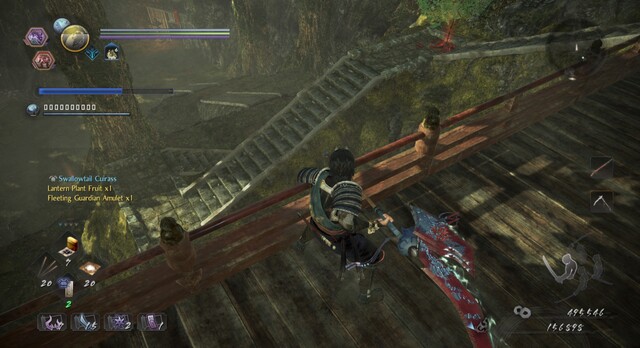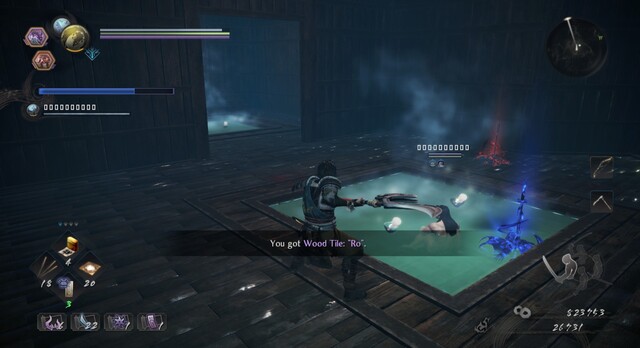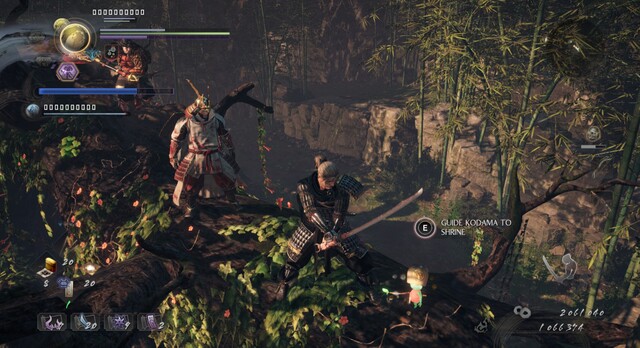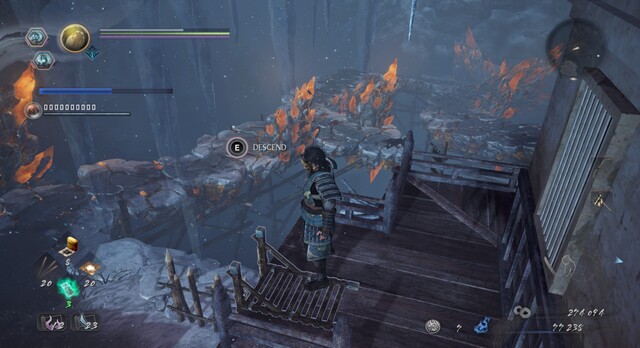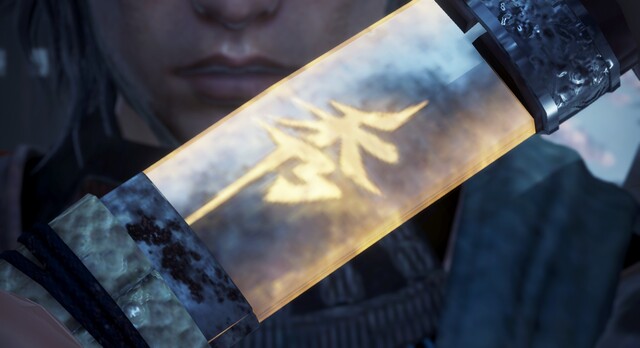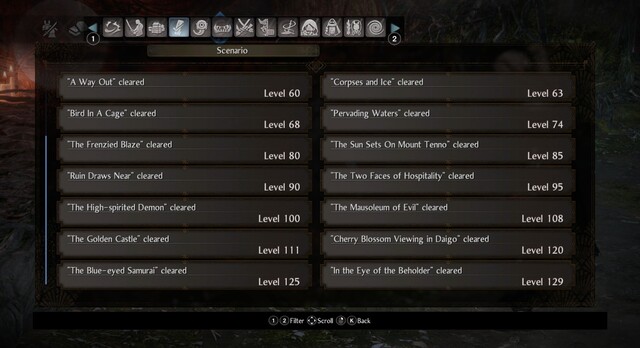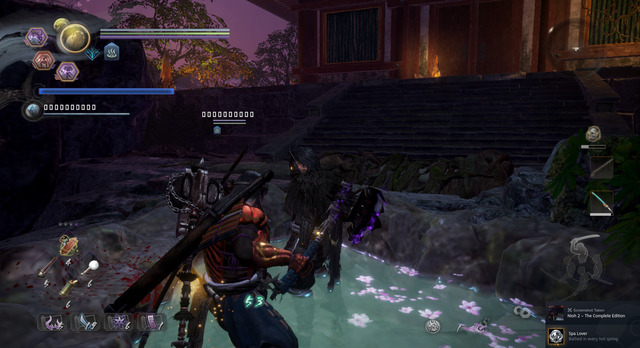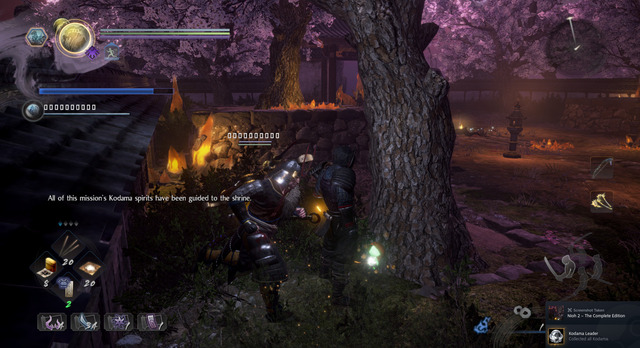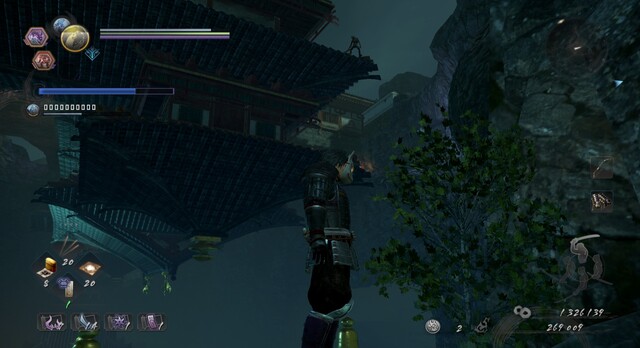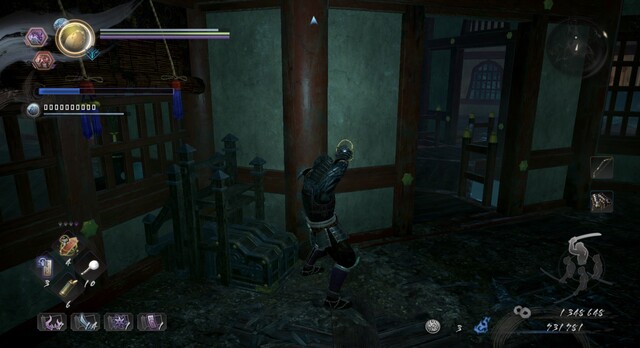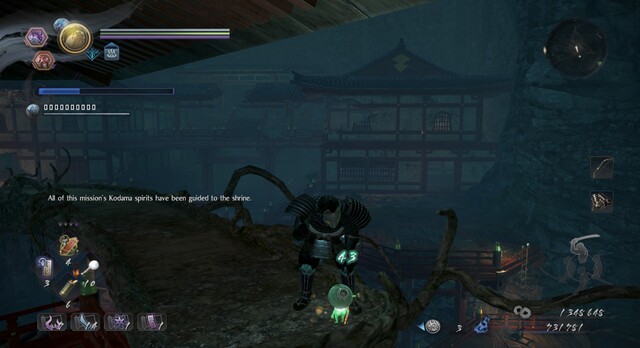Nioh 2 is a third-person action game following a player-created silent protagonist, a half-demon shapeshifter, whose mother was murdered under mysterious circumstances. The protagonist has since adulted into an era of perpetual war and spiritual turmoil. The events of Nioh 2 precede then run in parallel to that of the previous game.
- I played Nioh 1 and understand the game mechanics more from the time I wrote my review for Nioh 1.
- The two games have similar designs; therefore, much commentary about
game design carry over from the first game.
- Nioh 2 like Nioh 1 involve frequent player deaths and trial & error, having similar game designs to Dark Souls by From Software.
- The Nioh games, however, have complex itemization; equipment items grant special effects and bonuses (e.g my extremely awesome weapon).
- Getting a good item involves little time commitment as the crafting mechanics complement the itemization complexity.
- I played Nioh 2 under similar conditions as Nioh 1, buying the game for myself and a friend therefore having a consistent co-op partner.
Nioh 2 also re-uses some maps and areas from Nioh 1 but still has adequate new content.
Characters
Partial overview.
Protagonist
Canonically named Hi’de (秀) and nicknamed Hi’de’noji (translated as “Hiddy”) by Tokichiro, the protagonist is a human hybrid born between a demon and a former demon slayer who envisioned peace between human and demons. The protagonist is mostly player-created. As a shapeshifter, his or her appearance is customizable throughout the game.
The protagonist also has the ability to collect and integrate demonic soul cores dropped from slain enemies. Pertaining to game design, up to three abilities from monsters and bosses can be employed by the player. These abilities are moderated by an extra stamina bar called Anima.
The protagonist also understands the language of spirits. Some lines of dialogue are available after interacting with kodama and other entities.
The silent protagonist carries a dagger with his or her name inscribed on it. The kanji is 秀 which is pronounced similarly to hideru (秀でる), meaning “to excel or surpass”.
Tokichiro
Tokichiro is a self-described peddler of spirit stones. He carries a weapon for self-defense, though compared to others he is not as adept a warrior. He has a goofy, cheery attitude and approaches yokai with discretion, “not all yokai are bad”. He befriends the protagonist, and the two venture to serve the warlord Oda Nobunaga. When making requests to a figure of authority, he grovels profusely while, as a foil, the protagonist next to him does not.
Mu’myo
Mu’myo is a title within a clan of demon slayers. The current Mu’myo is a woman wearing a pelt of black feathers who wields a scythe. She slays demons nigh indiscriminately almost killing the protagonist until Tokichiro intervenes. In later missions, she appears as an co-op partner.
The protagonist’s father previously held the title of Mu’myo. Therefore, she and the protagonist have shared heritage through the clan.
Oda Nobunaga and Princess Noh
Oda Nobunaga is a warlord who has contending plans to unite Japan. The fate of he and his wife Princess Noh parallel that of the real historical figures of Sengoku Japan. That is, until the timeline of Nioh 1, when Oda Nobunaga is resurrected and Princess Noh incarnates as a yuki-onna.
There is a trend among Nobunaga’s army to collect tea utensils. Tea utensils collected through the game can be placed in a display case in the protagonist’s home. Doing so grants bonuses to Luck, money or item drop rates.
Senji Toyo
Senji Toyo is the blacksmith girl who bears an extremely strong semblance to Senji Tome from Nioh 1. Both are granddaughters of Senji Muramasa who wear a patch over one eye. Compared to Tome, Toyo’s blacksmithing business has a simplified catalog of patronage perks.
Ryunojo
Ryunojo is a stranded, starving soldier of the opposing force who appears in the mission Birds in a Cage. He begs the player for food, but the only options to choose from are Elixir and Dung Balls. “Feeding” him eventually drives him insane.
He also appeared in Nioh 1 as the strange man behind a door who cackles like a hyena and “collects” Dung Balls.
Maria
Maria, a blonde Spanish woman, is a boss from Nioh 1 whose story is continued in Nioh 2 as a minor antagonist. The Protagonist becomes involved in the hunt for her when she traveled to Byodo-In.
What’s new from Nioh 1
- the attribute Spirit has been merged with Magic
- Living Weapon, when a Guardian Spirit imbues a weapon, has been nerfed; known for replacing the health bar with a timer, the duration is short and more heavily penalized upon taking damage.
- Sloth Talisman has been nerfed, or at least isn’t as appealing to use compared to Lightning Spells.
- Whetstone drop rate has been reduced.
- The replacement of Earth and Wind elemental damage types with Purity and Corruption; both Purity and Corruption effects relate to damaging the opponent’s Ki or Anima.
- Yokai Weapons— they talk after you use them enough, up to four or five lines per weapon model.
Nioh 2 features additional weapon classes. The new additions are Switchglaive, Splitstaff, Gauntlets, and Dual Hatchets.
Switchglaive
A fictional morphing weapon, my first pick.
The switchglaive is a fictional weapon with a double-sided blade. The blade’s position can be mechanically shifted. Depending on the stance, the weapon takes the form of a scythe (high), naginata (middle), or clamp (low, called “guillotine”). This weapon can play similarly to the odachi in that attacks between different stances flow to one another, but unlike the odachi, the weapon’s damage scales with Magic. I don’t tend to use active skills with the Switchglaive, but I frequently switch stances.
Splitstaff
My favorite ability: Shin Crusher
The splitstaff is a fictional weapon that serves as both a staff and a nunchuck. It maintains the same form between stances, but holding down the button (or key) after attacking detaches the ends of the staff. Doing so causes rapid strikes which is a good follow-up after hit confirmation. The splitstaff can be versatile, having active skills with long ranges or wide striking arcs.
Fists
Fist weapons are the shortest ranged out of every weapon, but they have a high attack speed. Strong attacks on high stance come out about as fast as quick attacks on other weapons, so I had an easy time with breaking the enemies guard with fists. With this weapon, most of my attacks were not with active skills; however Wolf Claw (gain Anima upon landing a hit) deserves a special mention.
Hatchets
My favorite ability: Demon Undercut
Hatchets are small axes that are dual-wielded. They appear similar to Dual Swords; however, Hatchets can be thrown, and most active skills involve throws. Virtually all throwing skills involve significant start up time, and the player can not move while preparing to throw. Hatchets incline towards low damage; however, they can inflict high ki damage and leave the opponent open to grapples or final blows.
Technicals
Nioh 2 like Nioh 1 does not support Linux, but it is playable through Proton. This time, players with foreign names render as rectangles.
The game is playable on Proton 9.0-2. However, the game may hang in the skill tree. A node in the skill tree may have a video asset which auto-plays to show the skill’s effects or animations. Mousing over nodes too quickly may cause the game to hang. In most cases when that has happened, I terminated the program and lost some progress. So if this issue persists, it’s best not to assign skill points during a mission.
Controls
Like the previous game, Nioh 2 is designed for controllers. A big improvement for PC controls is at least having keyboard/mouse icons on HUD elements and labels. Because of that, I was more inclined to customize my controls.
I found myself comfortable with stance switches on the number row. However, that means I needed to rebind item shortcuts. Generally from other games, if I have stances or skills switching on the number row, I would access items on the function keys (F1, and so on). But it turns out function keys can’t be bound.
For reference in other games, I have keys 1-4 to switch Dante’s “stances” in Devil May Cry. I have similarly made function key and number row swaps in Diablo II: Lord of Destruction.
Key presses are not debounced between modifier keys. For example, if Shift was bound to Guard while Shift+E was bound to Holster Weapon then pressing Shift+E will only raise the character’s guard. So I think there are some missed opportunities for convenient controls.
My Playthrough
For Nioh 2, I decided to focus on Onmyo Magic and Ninjutsu for my character build. I wanted to try different skills, so my skill point allocation was dispersed into many skills instead of ranking up the ones I used. Partway through, I started to figure Onmyo Magic didn’t suit my playstyle too well because I was too conservative with talismans and didn’t get many proficiency points. But despite my mistakes, I didn’t need to respec.
My character mostly dealt lightning damage because enemies afflicted with “Shocked” are slowed down. While I don’t have exact numbers, between Shocked and Sloth Talisman, the two have similar effects. The difference is that some lightning spells hit more reliably and can strike multiple targets.
The Most Confusing Level
The Mausoleum of Evil was one of the first times in a long time where I have gotten lost in a video game. Contemporary level design in video games had trended towards linearity and still lean towards simplicity. So I appreciate the scale and relative complexity given that the game only provides to the player a radar and not a map.
I like the concept of running along the roofs of a sunken castle adjacent to cliffs and curved stone paths. I, however, found it strange that the building has roof-like structures on its underside as if it was a copy-paste by 3d modelers to fill in details.
Final Boss
To avoid spoilers, I won’t name the boss.
In Nioh 1, the final mission and boss encounter had taken me several attempts over days, (and I don’t mean Queen’s Eyes1). I didn’t mention this in the review for the first game because I assumed getting stuck on an intentionally challenging game would be normal. For instance, I was running out of health potions and resorting to alternatives like Spirit Stones.
To contrast, in Nioh 2, the final level and boss took me one attempt, and I didn’t realize it was the final boss. I recognized the antagonist, and I assumed some twist happens at the very end and a much harder boss would show up.
The mini-bosses leading up to the final encounter were less distinct as well. I thought of them like generic soldiers with slightly more health and voiced lines. But that’s could be reflective of the (lack of) talent within the faction’s military.
During the boss fight itself, there was also a strange sequence when the boss’s health bar depletes. He then lays on the floor before fullying restoring health. I had thought I missed a button prompt. However, the new set of behaviors afterwards indicated a distinct phase in the encounter.
Overall
- I completed the main game at 69 hours of playtime.
- My character used Onmyo Magic and Ninjutsu.
- my character uses light armor because more points are allocated to
Magic and Dexterity.
- to contrast, I played a medium/heavy armor “samurai” build in Nioh 1.
- I ignored talismans or passives that granted elemental resistances (e.g +x Resistance to Fire) until the very end, in a DLC, I came across a dark god of lightning.
- my character uses light armor because more points are allocated to
Magic and Dexterity.
- I completed the final mission of the base game “Cherry Blossom Viewing in Daigo” at level 120.
Compared to its predecessor, Nioh 2 took much more creative liberty with its narrative than its predecessor, having more original characters in the spotlight than historical figures. Regarding gameplay and combat, I appreciate the combination of fast-paced combat and RPG mechanics.2 However, because of how much more movement options the bosses can have over players (as opposed to the other way around), I inclined towards slowing things down and crippling them with abilities such as Shin Crusher: a pragmatic solution to fast enemies in a tough game, not reflective of the type of action I like.
Additionally, even as Onmyo Magic and Ninjutsu conceptually can leave a lot to imagination, most of the damage a player deals will be coming from weapons. So the two trees don’t lead to completely different playstyles in that the player remains a head-to-head melee fighter.
It’s also the case that investing points to specialize in a weapon class doesn’t grant a significant damage bonus over spreading points across different attributes. Which on the upside, the player doesn’t have to invest stat points in a certain way to meet damage threshholds.
Nuisances
Nioh 2 is distributed under similar terms to Nioh 1. See Legalese section. My commentary on that is unchanged.
The Skill Tree
Skills are presented in a tree. Starting from the center, there are four branches: top, left, right, and bottom. From there, each branch forks further. For that, finding certain skills can involve more effort than it should.
A common case is that the player had opened the Skill Customization menu and found that they haven’t yet unlocked a weapon skill that is bound to a certain control such as “Press (key combination) after (condition)”. Logically, the player then opens the Skill Tree.
There is no search function in the skill tree, and weapon skills are generally organized by stances (as opposed to binds). The player has to mouse-over each node for the description. The cursor will also snap to node, which makes sense for controllers but not so much for a mouse (at least at its current radius). As mentioned in Technicals, the game can hang in the skill tree.
When a menu like Skill Customization exists, I had thought it would make more sense to unlock skills from there, or at least had it highlight the path that needed to be taken to unlock a desired skill. It would also be an improvement if the nodes had at least different borders to indicate if they were a Passive Bonus, Active Skill, or Mystic Art.
